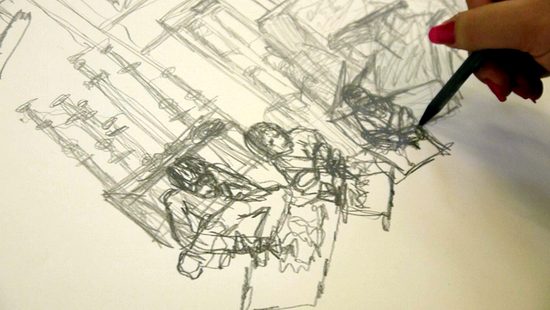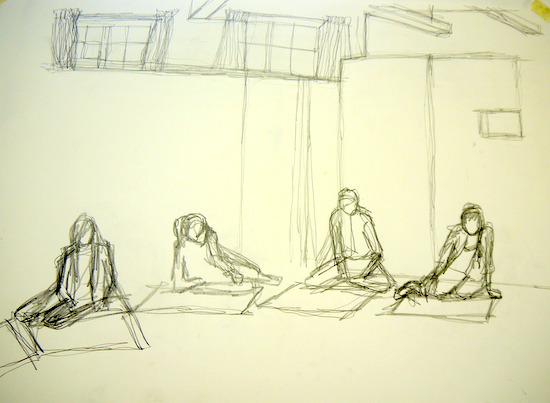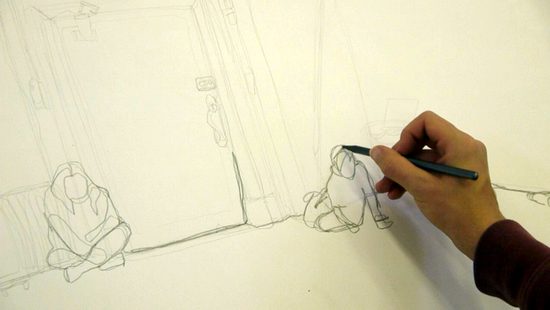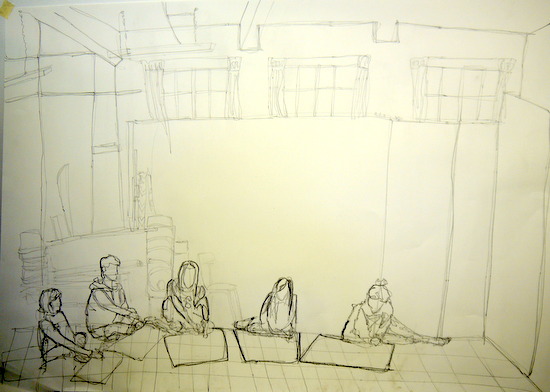Draw Together: Drawing Space
Introduction: What is Drawing Space?
During this online course you will look, draw and explore the spaces around you.

Rather than learning to draw space formally, in a technical sense, you will enjoy the freedom of interpreting the spaces which surround you by looking and mark making.
We hope this online course will help you to think about the spaces that you find exciting and inspiring, and how your very presence changes the spaces that you inhabit.
These exercises are based on workshops which took place with teenagers in Cambridge, at the Cambridge School of Art. We hope you’ll enjoy trying these ideas in your own time and space, and we look forward to seeing your work when you upload it to the moderated platform (please see below), where Paula Briggs and Sheila Ceccarelli, artists from AccessArt, and other artists and teachers, will also provide helpful feedback on your work.
These exercises should just be a starting point. We hope that as you start to share your work with other students, you will be inspired to try out new ideas and approaches. We’ll be happy to give you tips on how we think you can progress your work, and it’s a fantastic chance for you to be fed with different perspectives.

Exercise One: Continuous Line Drawing of a Space You Will Need
- Graphite pencils of various softness
- Charcoal
- Paper – We recommend having a go on big A1 paper – but any size paper will do!
- Inspiration!
In case you missed that here’s a step by step guide of what to do:
Getting Started
The point about this exercise is that it’s an ‘ice breaker’ and it can easily be transferred. That means that you can do it any time, any place, anywhere and with any drawing material. In this first exercise you will be making a simple, continuous line drawing of an interior or exterior space.

We’re very open about which kind of space you choose, but maybe the easiest way in, is just to draw whichever space you’re in now. Start off by just looking at the space that you are about to draw. Let your eye move about the space, taking in the lines made by walls, ceilings, floors, windows. Enjoy seeing the “volumes” within the space. What gives the space its character? How does it link to the outside space? How much can you actually see of your chosen space?
Then, pick up a pencil. A soft pencil is nice to work with because it gives you a nice, deep, black, dark mark but you might, alternatively want to use a hard pencil which will give you a very precise, clean mark and you can experiment with the sort of marks that different pencils make you could also try working with a piece of graphite that is very soft and will give you very satisfactory marks.
You are going to do make a ‘continuous line drawing’. This means your drawing consists of a single line, which travels across your page as your eye travels around the space. Let the pencil fill the paper with the rhythm of what you are seeing. Do not worry about detail or perspective or even what your drawing looks like. Just keep looking and keep your pencil moving. This will be a journey of exploration across the paper, connecting your eye and your hand. Keep drawing – this exercise might take 10 minutes or longer. Obviously the longer you work, the denser your drawing will become.

Remember!
- Keep your pencil on the paper!
- Vary your marks and pressure with which you push down on the pencil.
- You can choose an internal or external space’
- You can work near other people, or alone.
- Keep looking!

Exercise Two – Drawing People in Space using a Continuous Line
You might want to try this activity if the space you are drawing is inhabited by people. Try this activity on the same piece of paper as you used in Exercise One, to develop your drawing, and your perception of how spaces change when people are in them.
Repeat the activity in Exercise One – Continuous Line Drawing of a Space, this time concentrating on drawing the people which inhabit the space. Remember not to take your pencil off the paper as you draw the people. Think carefully about where on the page to start drawing the people – where in the space do they exist?
Remember:
- Keep looking and drawing in equal measures.
- Don’t assume you “know” that the people look like. Instead look carefully at the shapes they make and allow your continuous line to become a fluid representation.
- If your people are moving, then just try to capture an impression of them, again using fluid lines.
- Create areas of denser mark making, if you need to, to help “ground” your people, but still don’t take your pencil off the paper.
- Don’t worry about the continuous lines of the people being drawn over the continuous lines of your space.
- Relax! You’ll need plenty of concentration for this exercise but also confidence in the lines you are drawing!
- Remember to keep your eyes on the space and your pencil on the paper!




Move on to…
- Autobiographical Drawing Assignment
Using drawing and collage materials to exploring self portraiture. - Tying Your Work Together: Artist Aurora Cacciapuoti Introduces Japanese Book Binding
A simple demo on how to bind pages together.

Draw Together: Access Course Materials | AccessArt: Visual Arts Teaching, Learning & Practice
March 7, 2013 @ 2:17 pm
[…] Assignment 1: Drawing Space Exploring the power of drawing as a tool to ‘draw space’ and express how we interact with space and place. […]